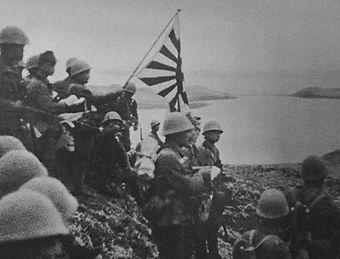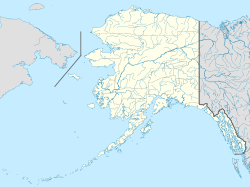Japanese Occupation Site, Kiska Island facts for kids
|
Japanese Occupation Site, Kiska Island
|
|

Japanese troops raising flag after invasion
|
|
| Location | Aleutian Islands, Alaska, United States |
|---|---|
| Area | 48,900 acres (19,800 ha) |
| Built | 1942 |
| NRHP reference No. | 85002732 |
Quick facts for kids Significant dates |
|
| Added to NRHP | February 4, 1985 |
| Designated NHL | February 4, 1985 |
The Japanese Occupation Site on Kiska Island is a very important historical place. It's located in the Aleutian Islands of Alaska. During World War II, the Imperial Japanese Navy took over this island. This was one of only two times enemy forces invaded North America during the war.
The Japanese built many defenses and buildings on Kiska. They left the island in 1943 after losing a big battle on Attu Island. Later, American and Canadian soldiers came and took back the island. They left in 1946. Today, the main part of Kiska Island is a National Historic Landmark. It's also part of the Alaska Maritime National Wildlife Refuge.
Contents
Kiska Island: A Wartime Story
Kiska is a small island at the western end of the Aleutian Islands. It often has stormy weather and thick fog. But it also has one of the best harbors in the area.
Japanese Invasion of Kiska in 1942
In World War II, the United States Navy had a small weather station on Kiska. Only ten men worked there. On June 6–7, 1942, Japanese forces invaded Kiska and Attu Island. They met no resistance. This invasion was planned to happen around the same time as their attack on Midway Island.
The Japanese leaders first planned to leave both islands before winter. But then they decided to keep them. Both islands were made stronger with defenses. Kiska became the main base for Japanese operations in the Aleutian Islands campaign.
Building Defenses on Kiska
On Kiska, the Japanese built an airfield for planes. They also set up many defenses along the coast and anti-aircraft guns. They created a submarine base and a seaplane base. Buildings were also made for their troops.
The naval facilities were mostly on the northwestern side of Kiska Harbor. The army facilities were at Gertrude Cove. The Japanese even built fake defenses all over the island. This was to trick enemy planes. The real defenses were hidden around their main bases. They were also at the North Head of Kiska Harbor.
Allied Response and Retaking Kiska
The Japanese invasion made the Americans respond. The United States Army Air Forces started bombing Kiska. These bombings became stronger as new airfields were built closer to Kiska. U.S. naval ships and submarines also attacked Japanese ships.
In May 1943, United States Army troops fought for twenty days to retake Attu Island. They won the Battle of Attu. Because of this loss, the Japanese made their defenses on Kiska even stronger. However, they secretly left Kiska Island on July 28, 1943. They never finished building the airfield.
Allied forces did not know the Japanese had left. On August 15, they arrived with many soldiers. This operation cost 200 men due to various reasons, including accidental "friendly fire" (soldiers accidentally shooting their own side). The island was then occupied by Allied forces.
What Was Left Behind
When the Allied forces arrived, they found many things left by the Japanese. There were three damaged ships on the beaches of Kiska Harbor. One ship was at Gertrude Cove. A sunken I-class submarine was found at the old submarine base.
The Allied military also made changes. They finished the airfield runways. They also put in more defenses. Allied forces left the island in 1946.
Kiska Island Today
In 1976, the U.S. Army checked what was left from the Japanese occupation. They found the submarine pen and many machine gun and anti-aircraft gun positions. They also found the wrecked freighter Nozima Maru, a small submarine, and a building that was used as officers' quarters.
Today, Kiska Island is part of the Alaska Maritime National Wildlife Refuge. You need special permission to visit the island. The central part of the island, where the Japanese bases were and where the Allied landing happened, was named a National Historic Landmark in 1985. It is also listed on the National Register of Historic Places. Kiska Island is part of the Aleutian Islands World War II National Monument.


